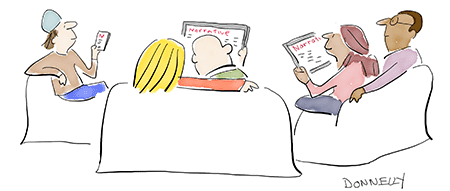Every year in early May, I can count on dealing with a barrage of phone calls and emails from relatives and friends, brother Dave in San Francisco and Aunt Betty in Arroyo Grande, all looking to “get down,” in the parlance of the racetrack, on the Kentucky Derby. They’re well aware I hold an online account with a bookmaker and will place their two- and five-dollar bets without skimming off any vigorish—a percentage of their winnings, that is, if any. They’ll also ask for hot tips, and I’ll oblige hesitantly, still uneasy in my role as backstretch sage.
I fell into it by accident. Some years ago, I wrote about a long season I spent at Golden Gate Fields, then as now a track slightly down on its luck, and people assumed (wrongly) I was an expert. At the time, racing was enjoying a rare moment of glory. In the past five years, Secretariat (1973), Seattle Slew (1977), and Affirmed (1978) had all won the Triple Crown. Only eight other colts had done that since the Kentucky Derby was first run in Louisville in 1875. It would be thirty-seven years before American Pharaoh duplicated the feat in 2015. Out of 4,224 entrants in the Derby over 142 years, there’ve been just twelve Triple Crown winners.
Like most racing fans, I thought the world of Secretariat. Known as Big Red for his size and chestnut color, he had speed to burn and won the Belmont Stakes by a record thirty-one lengths. Seattle Slew cost his owners only $17,000, but he entered the Derby unbeaten and emerged the same way, the first colt ever to do so. Affirmed had the toughest Triple Crown campaign against his unrelenting rival, Alydar. Although Affirmed won all three races, his total margin of victory was only about two lengths. He had such heart his owners buried him whole, the ultimate accolade for a racehorse.
I’d watched Affirmed’s and Alydar’s races on TV with my pal Arnold Walker, a fashion plate of sorts, often seen at the track in a pin-striped suit and a lime-green Lacoste polo shirt. Arnold loved to gamble, and in my book I talked about his ideas on how to bet successfully. To call his theories esoteric doesn’t do them justice. They involved magical thinking and finger-crossing, but they were part of the racetrack lore I hoped to capture. Horse fanciers and racing fans understood, and I received some complimentary letters, including one from Keene Dangerfield, a highly regarded steward in Kentucky.
It was the sort of letter I myself might write after staying up late to finish a book I liked, eager to share my feelings with the author. Keene Dangerfield thought I’d been honest and clear-sighted, unafraid to portray racing at its worst as well as its best, and for that he was grateful and invited me to visit him at Churchill Downs if I ever made it to Louisville. I appreciated his kind words and promised I’d look him up if I ever got the chance, which I’m sure he doubted would ever happen. But he was wrong.



